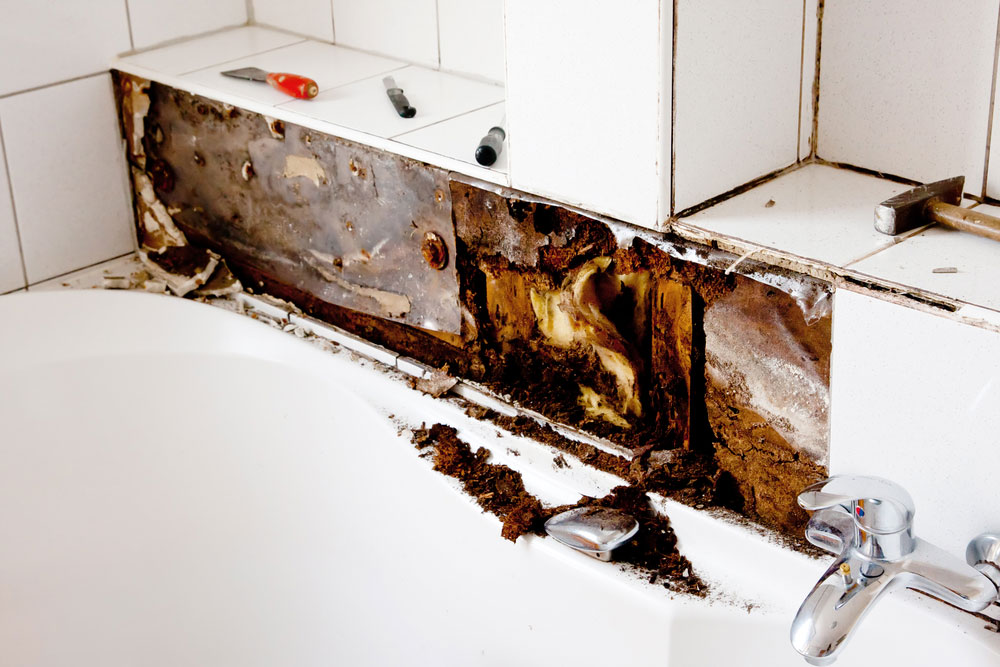Ways to Repair a Water-Damaged Wall in the Bathroom
Ways to Repair a Water-Damaged Wall in the Bathroom
Blog Article
We've come across this post about How to Prevent Bathroom Water Damage directly below on the net and felt it made perfect sense to share it with you on my blog.

The bathroom is incredibly vulnerable for moist accumulation and potential water damage due to the constant use water in it. This post uses basic evaluation methods to help spotting water damage hazards.
The constant use water in the washroom makes it exceptionally prone for moist accumulation and possible water damages. By checking it frequently, you can decrease water related problems.
The adhering to collection of evaluations is very easy to do as well as should be done once in every 3 months in order to keep your restroom in good shape and also to avoid prospective water damages caused by the bath tub, the shower, pipeline joints as well as plumbing, sinks, cabinets, and also the bathroom
Do not overlook carrying out these inspections and also be extensive while performing them. Keep in mind that these straightforward assessments can save you a lot of cash by supplying very early signs for water damage
Bath tub as well as Shower
The shower and bath tub need special focus as well as maintenance. Examine the floor tiles as well as replace if fractured. Make certain that there is no missing grout between the floor tiles. Examine and also replace cracked caulking at joints where the wall surfaces meet the floor or the bath tub. Clogged drains pipes as well as pipelines issues will stop the bathtub from drying out and might indicate significant issues beneath the tub. Consult with a specialist instantly to stop structural damages. Take note of stainings or soft areas around the bath tub walls as they might indicate an interior leakage.
Plumbing
Signs for water damage are tough to spot given that most pipes are mounted inside the walls.
Pay unique attention to flooring and also walls wetness and also spots as they might indicate an undetectable plumbing trouble. Check wetness degrees in adjacent rooms also.
Sinks as well as Cabinets
Sinks and also cabinets are revealed to wetness as well as moisture daily and are typically forgotten. Inspect frequently under the sink and also on the countertop above it. Fix any kind of drip in the trap as it may recommend drainpipe problems. Take a look around the sink, sluggish draining pipelines may suggest an obstructed drain. Replace sink seals if they are split or loosened.
The Commode
The toilet is a susceptible water joint. Examine the water lines and also search for leaks around the bathroom seat, in the pipe, and also under the water container. If you detect any type of indications of dampness on the flooring around the commode, check for leaks in the toilet rim as well as storage tank seals.
Know that hanging commode dish antiperspirants increases the chances for clogs.
TIPS TO PREVENT WATER DAMAGE IN THE BATHROOM
The average household uses approximately 80-100 gallons of water per person per day. For a family of 4, that's almost 2,500 gallons of water a week! The largest portion of this consumption comes from bathroom use. Flushing the toilet uses the most water, followed by taking a shower or bath. With that much water running through the home, water damage in the bathroom is bound to happen. Knowing how to spot signs of a water leak is essential to preventing long-term damage. This guide provides you with tips to reduce the impact of water damage on your bathroom.
CAUSES OF BATHROOM WATER DAMAGE
Pipe breaks are the most common cause of water damage we see in our daily jobs. The age of a pipe plays a large role in a pipe break as well as corrosion. Over time, the metal begins to break down, allowing water to escape. Frozen pipe breaks are also a concern in the winter months. Toilet overflows caused by paper products or children flushing inappropriate items. Degraded caulking around the toilet or bathtub can allow water seepage, sometimes behind the fixture, into the subfloor or walls. Condensation forms when the water in a pipe is cooler than the air temperature. Beads of water form on the exterior of the pipes, sometimes so much so that the water begins to drip and pool below. Sink or shower backups created by poor drainage. HOW TO PREVENT WATER DAMAGE IN YOUR BATHROOM
Inspect your toilet supply line for worn or frayed hoses and replace them as needed. Winterize your plumbing to prevent a frozen pipe break. Use vent fans to prevent condensation that can lead to mold growth. Routinely check and replace degraded caulking around your toilet or bathtub. Increase the temperature in your toilet tank and insulate your pipes during the warm summer months to keep condensation from forming. Use child safety locks on the toilets. Flush only toilet paper. "Flushable" wet wipes are actually not good for your plumbing system. Additionally, feminine hygiene products should not be flushed. Prevent water from escaping the tub or shower. Make sure shower curtains are in good condition. Inspect shower doors and replace the seal strip if necessary. Wipe up any water that accumulates on the floor and use bath mats. Water left to sit can cause damage to the tiles and flooring. Refrain from using bath products containing heavy oils to avoid a clogged drain.

As a passionate reader about How to Fix a Water Damage Bathroom, I was thinking sharing that excerpt was essential. If you appreciated our article kindly remember to share it. I truly appreciate reading our article about How to Repair and Prevent Bathroom Water Damage.
Free Estimate Report this page